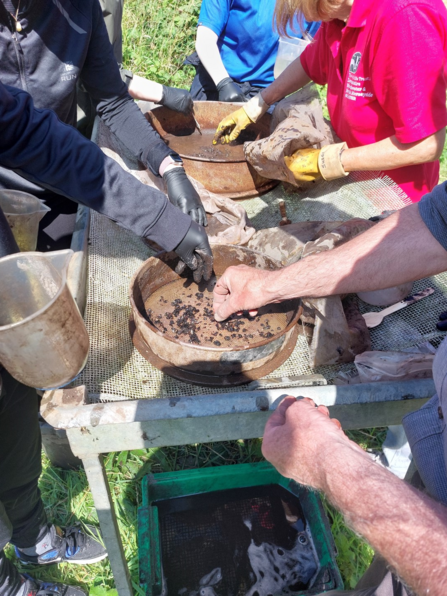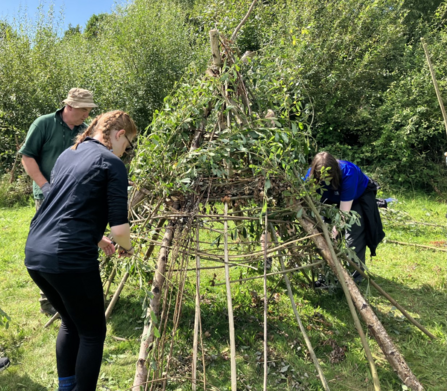Lunt Meadows Nature Reserve in Sefton is best known for its fantastic array of wildlife, including marsh harriers, water voles and barn owls. If that wasn’t special enough, it is also home to one of the most important prehistoric archaeological discoveries in the country: the remains of Mesolithic stone age settlements, which are dated between 7,000 to 9,300 years old. Over a 12-year period, National Museum Liverpool’s Curator of Prehistoric Archaeology, Ron Cowell, led excavations, unearthing several different settlements and over 15,000 artefacts from the middle stone age.
Learning archaeological skills at Lunt Meadows
NML (National Museums Liverpool)
Ron Cowell
Although the digging is now over, there are still plenty of ways for people with a passion for archaeology or prehistory to get involved. So it was with great pleasure that Ron (who is now Honorary Research Associate since retiring as Curator in 2022) and the Lunt Meadows team recently welcomed a group of aspiring archaeologists from the Museum of Liverpool Emerging Archaeologist programme.
Museum of Liverpool Emerging Archaeologists (MoLEA) is an exciting opportunity for young people aged 16-24 to gain direct hands-on experience of their local archaeology through workshops and projects. It runs each year during the first week of August and is aimed at young people who are interested in archaeology, heritage and museums, but are not currently studying archaeology in higher level education.

NML (National Museums Liverpool)
After an introduction to Lunt Meadows and the Mesolithic, the first task of the day was to search through bags of soil excavated from the archaeological dig. This exercise is called wet sieving. Like panning for gold, wet sieving involves placing the soil in archaeological sieves and pouring water over them, washing fine sediments away to reveal any plant or stone materials. The participants found some very small pieces of flint stone, revealing that thousands of years ago, someone had been making a tool. It’s exciting to discover artefacts when sieving and consider that you are the first person to lay eyes on an item for thousands of years. Even finding nothing is a result though, because it helps to figure out if specific areas of the settlement are being used for certain tasks, such as cooking, like they are in modern homes.
The discovered flint was bagged, labelled and taken back to the Museum of Liverpool, ready for the next stage in a long and careful process that helps us to learn about the people who lived at Lunt thousands of years ago.
Once back at the museum, Ron and the volunteers enter the results into digital spreadsheets and use ArcGIS, a Geographical information system, to plot on maps of the settlement where each stone tool was found. One pattern they have already confirmed by mapping the finds, is that earlier prehistoric users of the site had mainly flint tools, whereas generations later, the people on Lunt were using chert, a different rock, to make tools. Neither stone occurs locally, so the people were either bringing it to site or trading with others for it.
As well as wet sieving, the young people took part in some experimental archaeology, learning how to harvest stinging nettles and process them into string. Nettle stems make a very strong string, and string and cordage would have been incredibly useful to hunter-gatherers in the Mesolithic period, needed for a multitude of tasks from building fish traps to creating containers. The staff and volunteers at Lunt Meadows have been learning stone age skills under the guidance of Dr Barry Taylor and Dr Amy Gray Jones from the Dept. of History and Archaeology, University of Chester. Thanks to Barry and Amy, the team are now able to share these skills with visitors to Lunt, helping people to connect with the past and learn something new.
Alongside making string, some of the young people helped to build a replica of a Mesolithic-style house. They carefully wove willow branches around the outside of the house, all the while discussing how prehistoric people may have constructed such houses: what material they would have used, how they would have transported them and how location and time of year could influence designs. The young people did a brilliant job, even using a goat skin from our kit of replica artefacts as a doorway to the house.
We hope the group had a great experience at Lunt Meadows and left with new skills and knowledge of the different areas of work available in archaeology.

NML (National Museums Liverpool)
Our archaeological engagement work at Lunt Meadows is part of the Mesolithic and Modern Life Project at Lunt Meadows. This project is funded by The National Lottery Heritage Fund and aims to give visitors and the extended community an understanding of how humans have interacted with the landscape over thousands of years, how landscape changes affect human lives and how these choices influence our future. It is a 5-year long partnership between Lancashire Wildlife Trust, the Environment Agency, the Museum of Liverpool, Soroptimist International Crosby and the Dept. of History and Archaeology, University of Chester.
If you are a member of a community group, special interest group or work in an education setting and would like a bespoke visit to Lunt Meadows to learn about archaeology, wildlife or sustainable urban drainage systems, please contact us at luntinfo@lancswt.org.uk.

